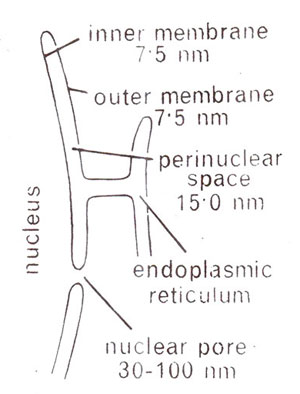Nuclear envelope

Fig. 6.2. Nuclear membrane showing double structure.

Fig. 6.3. Formation of organelle initial from nuclear envelope.
Each unit membrane is 7.5 nm (1 nm = 10 Å) in diameter and perinuclear space may vary from regular 15 nm wide spaces to irregular cavities several hundred times wide. Outline of nuclear envelope is smooth and interrupted by pores which appear circular in surface view. Diameter of these pores varies from 30 nm 100 nm. In sections, it is obvious that at the boundary of these pores, outer and inner unit membranes are joined. These pores provide direct contact between nucleus and cytoplasm and allow import and export of protein and, RNA (particularly export of messenger RNA, which is synthesized in the nucleus and then reaches cytoplasm for protein synthesis). The double membrane also takes part in giving rise to the initials of cell organelles like mitochondria or plastids (Fig. 6.3).




